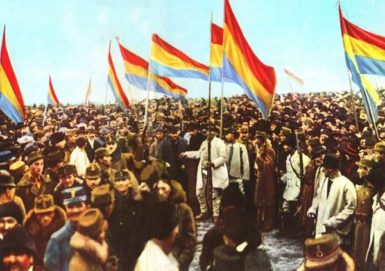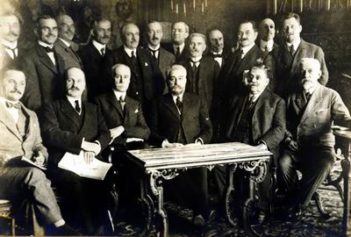 December 1 is the National Day of Romania, adopted by law after removing the communist regime. From a historical perspective, December 1, 1918, the National Assembly of Alba Iulia, consisting of 1,228 delegates and supported by over 100,000 Romanian came from all over Transylvania and Banat, adopted a resolution by which it was sanctioned union of all Romanians in Transylvania, Banat whole (between Mures and Tisa rivers and the Danube) and the Hungarian Country (Crisana, Maramures and Satu Mare) with Romania.
December 1 is the National Day of Romania, adopted by law after removing the communist regime. From a historical perspective, December 1, 1918, the National Assembly of Alba Iulia, consisting of 1,228 delegates and supported by over 100,000 Romanian came from all over Transylvania and Banat, adopted a resolution by which it was sanctioned union of all Romanians in Transylvania, Banat whole (between Mures and Tisa rivers and the Danube) and the Hungarian Country (Crisana, Maramures and Satu Mare) with Romania.
 On December 1, 1918 thus epitomizes the struggle of Transylvanian Romanians for National Unity and marks the creation of Greater Romania, being a continuation of previous actions unionist brothers from Bessarabia (March 27, 1918) and Bukovina (15 / November 28, 1918).
On December 1, 1918 thus epitomizes the struggle of Transylvanian Romanians for National Unity and marks the creation of Greater Romania, being a continuation of previous actions unionist brothers from Bessarabia (March 27, 1918) and Bukovina (15 / November 28, 1918).
Romanian people knew when to capitalize admirably favorable external environment created after World War I and the disintegration of the Tsarist and Austro-Hungarian empires.
 As underscore the historian Florin Constantiniu, “… Great Union of 1918 was and remains the most sublime page of Romanian history. Its greatness lies in the fact that national unity is not the work of any politician, any government or party; is the historical fact of the whole Romanian nation, momentum achieved in a power gushed from the depths of consciousness unit, controlled by leaders of political impetus to it remarkable political intelligence to guide the desired goal. […]
As underscore the historian Florin Constantiniu, “… Great Union of 1918 was and remains the most sublime page of Romanian history. Its greatness lies in the fact that national unity is not the work of any politician, any government or party; is the historical fact of the whole Romanian nation, momentum achieved in a power gushed from the depths of consciousness unit, controlled by leaders of political impetus to it remarkable political intelligence to guide the desired goal. […]
Great Union was not the result of Romania’s participation in the war. No supporters of the Entente nor the Central Powers did not took into account the Russian revolution and the collapse of the monarchy. Their reasoning joined traditional formula of the power relations between: Entente victory will give us Bukovina, Transylvania and Banat, Central Powers victory will give us Bessarabia; a victory excluded the other, so nobody should be possible to see how all these provinces to come almost simultaneously in the borders of the Old Kingdom. […]
Not a military victory that laid the foundation of Great Romania, but the nation will act to give the Romanian territorial reinforcement institutional-is the national state. […]
A historical necessity – the nation must live in a nation state – has proved stronger than any government or party, guilty of selfishness or incompetence, and setting in motion the nation that gave him enormous power that over all adversities aspiration to give life to his home country. “
Bessarabia was the first province that was united with the motherland
Unirea came amid dismantling Russian Empire with the proclamation of the principle of self-determination up to separation from multinational empire that forced Romanian province was incorporated in 1812.
 On 27 March 1918, the National, which included representatives of all nationalities, voted in favor of the Union Moldavian Democratic Republic (Bessarabia) with Romania, as follows: of the 135 deputies present, 86 voted in favor of the Union, three voted against and 36 abstained, 13 MPs were absent. Reading result was accompanied by thunderous applause and enthusiastic shouts “Long live the union with Romania!”
On 27 March 1918, the National, which included representatives of all nationalities, voted in favor of the Union Moldavian Democratic Republic (Bessarabia) with Romania, as follows: of the 135 deputies present, 86 voted in favor of the Union, three voted against and 36 abstained, 13 MPs were absent. Reading result was accompanied by thunderous applause and enthusiastic shouts “Long live the union with Romania!”
Bucovina was the second province that was united with the motherland
 90 years ago, on November 28, 1918, it held the proclamation of Bukovina’s union with Romania, important historical moment in National Unitary State Romanian, along with the union prior Bessarabia – on 27 March – and the eventual union of Transylvania, December 1, 1918 .
90 years ago, on November 28, 1918, it held the proclamation of Bukovina’s union with Romania, important historical moment in National Unitary State Romanian, along with the union prior Bessarabia – on 27 March – and the eventual union of Transylvania, December 1, 1918 .
“If we take the time to halt a little on the threshold of the Land blackened beech, On November 28, 1918 it is an open book of pain and glory of our nation. And the first words of this book tell us that we have no Bucovina country. Bucovina, with Putnele, Suceviţele, Voroneţurile and Cosminele them is the very heart of our history. For Bucovina is no border, but the fireplace, the heart of a nation. Cradle of history. And hearth, the heart can not be given to anyone, ever. It can only be breached, made-in chains and held until Providence justice comes and slams him to the ground on the oppressors. And this day the restoration of justice in the world will come! (…) We believe too much in the golden future of the nation, let us prophesy churches resurrection of Stephen the Great and fulfillment of new Romanian geography. We need this for our geographical integrity by far in history to create a culture of giving and the world, crazed material and worldly domination, a new spirituality in Christian and deeply human sense (…). Let us pause a moment to listen to the call instead and earth monasteries and beech trees. Răzvidim voice to the crypt from Putna on 28 November “(Basil Posteucă,” Romanian Word “, Nov., 1992, p.16).
 Transylvania was the third province that was united with the motherland
Transylvania was the third province that was united with the motherland
Union of Transylvania with Romania on December 1, 1918 is the main event of Romanian history and also achieve a goal of inhabitants of ancient Dacia borders.
“The National Assembly of all Romanians in Transylvania, Banat and the Hungarian Country, gathered by its rightful representatives at Alba Iulia on November 18 / December 1, 1918, decrees the unification of those Romanian and all territories inhabited by juveniles with Romania. Assembly proclaims above all the inalienable right of the Romanian nation to the whole Banat, between Mures, Tisa and Danube. “(Vasile Goldis)
